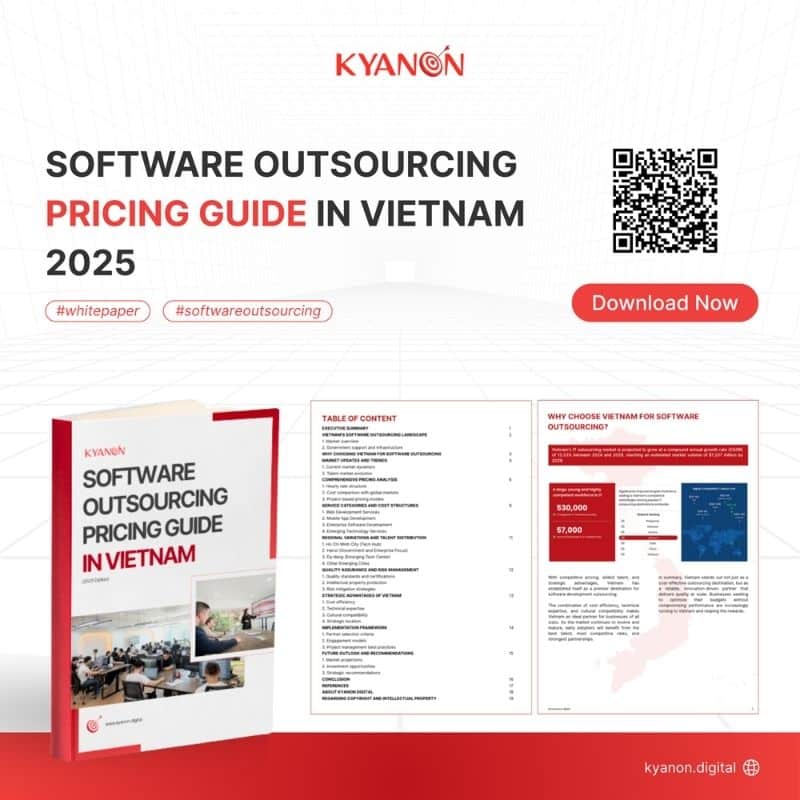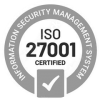In the rapidly evolving tech industry, dedicated team hiring has become a strategic approach for organizations aiming to scale their development capabilities efficiently. While this model offers benefits such as access to specialized talent and accelerated project timelines, it’s essential to recognize the hidden costs of hiring a dedicated team that can impact your return on investment.
Understanding these dedicated team hiring risks is crucial for businesses seeking to leverage dedicated hires effectively. In the sections below, Kyanon Digital will conduct a comprehensive dedicated hiring solutions cost analysis, shedding light on common pitfalls and strategies to mitigate them.
Further reading:
- From MVP to Robust Product: Hire Dedicated Development Team For Startup Growth
- How to Evaluate the Cost vs. Value of Hiring a Dedicated Software Development Team
- The Benefits Of Dedicated Team Model For Startup Agility
Hiring process for a dedicated software development team
Hiring a dedicated software development team is a strategic move for companies aiming to scale quickly, access specialized talent, and accelerate product delivery. However, the success of dedicated hiring hinges on a structured and thorough process. From clearly defining project requirements to vendor evaluation and seamless onboarding, each step plays a critical role in mitigating risks and optimizing outcomes.

Step 01: Define your needs
Start by clearly outlining your project’s technical requirements, team structure, and experience expectations. This ensures alignment between your goals and the expertise of the dedicated team.
Step 02: Research vendors
Evaluate vendors based on their specialization, talent scalability, certifications, and client reputation. Consider nearshore or offshore teams for optimal time zone compatibility and cost efficiency.
Step 03: Request proposals
Send detailed requirements—including roles, skillsets, timeline, and budget—to shortlisted vendors. Request transparency on hiring procedures, pricing, and team availability.
Step 04: Interview key team members
Interview senior profiles like tech leads to assess their capabilities and cultural fit. For other roles, leverage the vendor’s vetting process or assign a test task or trial period if needed.
Step 05: Negotiate the contract
Agree on a contract that outlines pricing, scalability, security, and performance metrics. Include SLAs to define availability, communication standards, and quality benchmarks.
Step 06: Onboard and integrate the team
Ensure smooth onboarding by providing tools, documentation, and clear workflows. Foster collaboration through structured communication and ongoing integration with your internal team.
For a detailed breakdown of each step in the hiring process, explore our complete guide here.
The hidden costs of hiring a dedicated team
The global IT services outsourcing market is projected to reach USD 611.80 billion in 2024, with expectations to grow to approximately USD 1,345.48 billion by 2034, reflecting a compound annual growth rate (CAGR) of 8.20% over the forecast period (Precedence Research). A key driver of this expansion is the rising adoption of the dedicated team model, which is gaining traction over conventional fixed-scope outsourcing approaches due to its inherent flexibility and stronger alignment with clients’ long-term strategic objectives.
However, while this model offers clear advantages, it also introduces a range of hidden costs and operational risks that are often overlooked during the early decision-making phase.
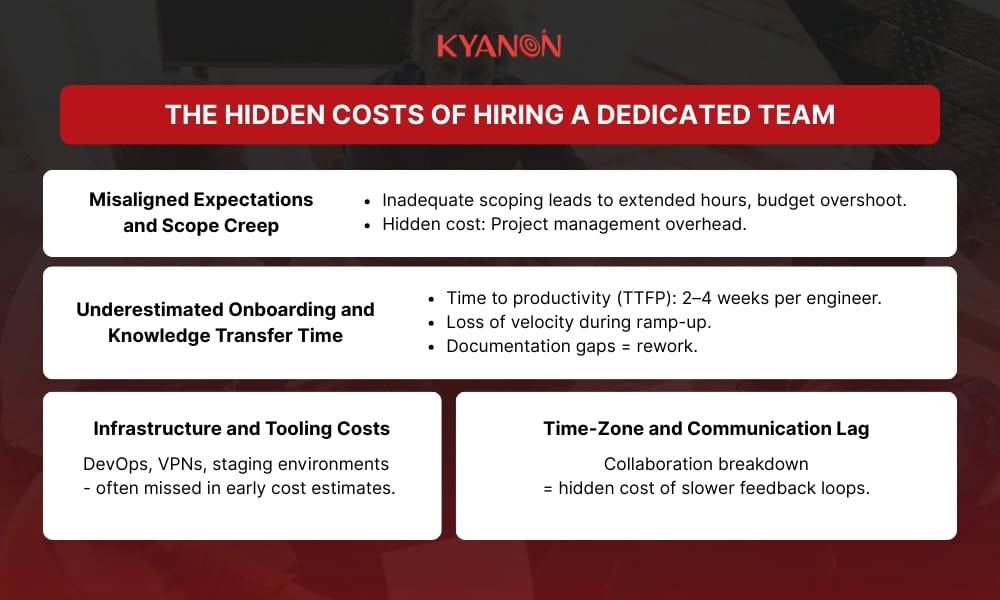
Misaligned expectations and scope creep
One of the most frequent yet underestimated risks in dedicated hiring is the misalignment between initial project expectations and the actual delivery scope. Inadequate scoping and vague requirements often result in extended development timelines, ballooning costs, and scope creep. Without a clear roadmap, dedicated hires may struggle to prioritize tasks effectively, leading to inconsistent outcomes and strained client-vendor relationships. The hidden costs of hiring a dedicated team in such scenarios typically manifest as increased project management overhead and resource misallocation, which directly impact the return on investment.
Moreover, when dedicated team hiring risks are not properly accounted for during early planning, businesses face an uphill battle in managing deliverables and maintaining velocity. As seen in several industry cases, unclear KPIs and shifting goals force teams into reactive modes, which reduces overall productivity and increases friction between in-house and external developers. These pitfalls emphasize the importance of upfront clarity, detailed documentation, and realistic time and budget estimates in the dedicated team hiring process.
Underestimated onboarding and knowledge transfer time
A critical yet frequently misjudged factor in dedicated team hiring is the time required to onboard new engineers and bring them to full productivity. The average Time to Full Productivity (TTFP) ranges from 2 to 4 weeks per developer, during which project velocity often dips. Without structured onboarding processes, teams may experience delays, friction in communication, and inconsistent code integration.
Further compounding the issue are documentation gaps, which lead to repeated errors and unnecessary rework. These inefficiencies, though subtle, contribute to the hidden costs of hiring a dedicated team, often undermining initial ROI assumptions. Overlooking this ramp-up phase can derail delivery timelines and strain in-house resources managing the transition.
Infrastructure and tooling costs
A commonly underestimated aspect of dedicated hiring is the cost of setting up and maintaining the right infrastructure. Essential components like DevOps pipelines, VPN configurations, and staging environments often fall outside initial vendor estimates. Without careful planning, these technical requirements introduce unexpected expenses that can significantly inflate the total project budget.
Beyond direct costs, infrastructure gaps can also hinder productivity and delay deployment timelines. This adds to the broader dedicated hiring solutions cost analysis, where overlooked tooling investments create long-term inefficiencies. Companies must account for these backend necessities early to ensure the development environment supports team velocity from day one.
Time-zone and communication lag
Time-zone mismatches often introduce a silent but significant risk in dedicated team hiring – communication delays. When real-time collaboration becomes difficult, feedback loops slow down, blocking key decisions and delaying iterations. Even minor lags in response can accumulate into project slowdowns, especially in agile environments where rapid cycles are essential.
The hidden costs of hiring a dedicated team also include the operational friction caused by misaligned working hours and asynchronous updates. Without well-defined protocols and overlapping availability windows, the risk of misunderstanding requirements or missing deadlines increases, affecting overall delivery performance and stakeholder satisfaction.
Transform your ideas into reality with our services. Get started today!
Our team will contact you within 24 hours.
Common pitfalls in dedicated team hiring
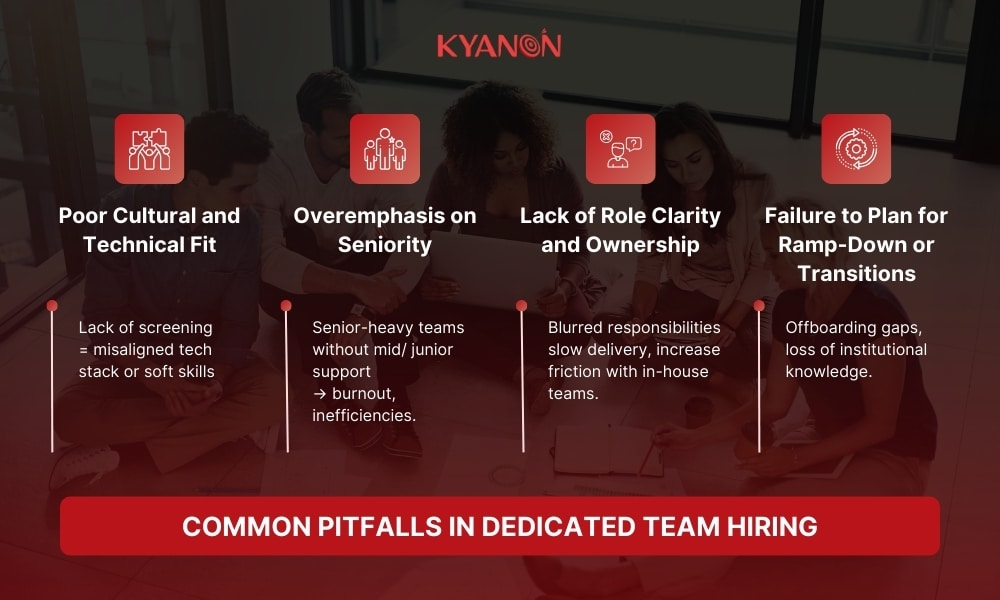
Poor cultural and technical fit
One of the most underestimated risks in dedicated hiring is failing to evaluate both cultural alignment and technical compatibility. When organizations skip a thorough screening process, the result can be a team that may technically qualify on paper but struggles to integrate with the company’s workflows, values, or long-term vision. This disconnect often leads to inefficient collaboration and slowed project momentum.
Additionally, overlooking essential soft skills or a mismatch in technology stacks can result in rework, delays, or the need for additional onboarding. These issues contribute significantly to the hidden costs of hiring a dedicated team – costs that are not always apparent during initial budget planning. Conducting comprehensive vetting and aligning expectations early can help avoid these pitfalls and ensure long-term team synergy.
Overemphasis on seniority
A common misstep in dedicated hiring is constructing teams composed predominantly of senior engineers without a balanced inclusion of mid-level and junior developers. While senior professionals bring invaluable expertise, assigning them to routine tasks can lead to inefficiencies and increased costs. Moreover, this imbalance may hinder knowledge transfer and mentorship opportunities, essential for cultivating a resilient and adaptable team.
An overreliance on senior talent can also contribute to burnout, as experienced developers may face heightened pressure to deliver without adequate support. This scenario underscores the importance of a diversified team structure, where responsibilities are appropriately distributed and growth pathways are available for less experienced members. Such an approach not only enhances productivity but also fosters a sustainable and collaborative work environment.
Lack of role clarity and ownership
A frequent yet underestimated challenge in dedicated hiring is the absence of clearly defined roles and responsibilities. When tasks and ownership are ambiguous, it leads to duplicated efforts, missed deadlines, and friction between in-house and external teams. This lack of clarity can cause stress and reduce productivity, as team members may be unsure about their duties and expectations.
Moreover, the hidden costs of hiring a dedicated team often include the time and resources spent resolving conflicts arising from role ambiguity. Without explicit role definitions, teams may experience decreased morale and increased turnover, undermining the effectiveness of the dedicated hiring solutions cost analysis. Establishing clear job descriptions and communication channels is essential to mitigate these risks.
Failure to plan for ramp-down or transitions
A critical yet often overlooked aspect of dedicated hiring is the absence of a structured ramp-down or transition strategy. Without a clear plan for offboarding, organizations risk losing valuable institutional knowledge, leading to operational disruptions and decreased productivity. Departing team members may take with them undocumented insights and processes, creating gaps that are difficult to fill.
Moreover, the hidden costs of hiring a dedicated team extend beyond onboarding and active collaboration. Neglecting the transition phase can result in increased expenses related to retraining, process realignment, and potential delays in project timelines. Implementing a comprehensive offboarding process, including knowledge transfer sessions and thorough documentation, is essential to mitigate these risks and ensure continuity.
Dedicated hiring solutions cost analysis
When evaluating dedicated hiring models, it is essential to consider the financial implications of each approach. In-house teams often entail higher fixed costs, including salaries, benefits, and infrastructure. Outsourcing can reduce expenses but may introduce challenges related to control and communication. Dedicated teams offer a balanced solution, combining cost efficiency with greater alignment to project goals.
For a more accurate and tailored estimate, please reach out to the Kyanon Digital team directly.
ROI calculator guidance for dedicated hiring
Evaluating the return on investment (ROI) is crucial when considering dedicated hiring for software development projects. A structured ROI calculator can assist in comparing the costs and benefits of this model.
Beyond direct expenses, it’s essential to account for potential gains such as increased revenue, faster time-to-market, and enhanced product quality. These benefits contribute to a comprehensive understanding of the hidden costs of hiring a dedicated team and the associated ROI. Utilizing ROI calculators enables organizations to align their dedicated hiring strategies with broader business objectives, ensuring cost-effective and efficient project execution.

To evaluate the ROI of hiring a dedicated software development team, businesses can apply a simple formula:
ROI = (Net gain from investment – Cost of investment) / Cost of investment.
Key metrics to assess include development velocity, time-to-market acceleration, cost savings compared to in-house hiring, and long-term team scalability. Factoring in quality improvements and reduced downtime from efficient workflows also contributes to a comprehensive ROI picture.
For a detailed guide on calculating ROI and understanding the full value of a dedicated team, explore our blog here.
How to mitigate risks in dedicated hiring
Due diligence before partnering
In the realm of dedicated hiring, conducting thorough due diligence is paramount to ensuring successful collaborations. This process involves a comprehensive evaluation of potential partners, focusing on aspects such as code quality, adherence to security standards, and verification of past project references. Assessing the technical proficiency and experience of the development team is crucial to ascertain their capability to meet project requirements. Additionally, reviewing code repositories, version control systems, and documentation practices provides insight into the team’s development methodologies and quality assurance processes. Conducting security audits to identify vulnerabilities and assess the effectiveness of existing security measures is also essential.
Beyond technical assessments, it’s vital to ensure that the offshore team complies with relevant security and compliance standards. Implementing practices such as multi-factor authentication, end-to-end encryption, and role-based access control can significantly enhance data security. Moreover, understanding and adhering to industry-specific compliance standards, such as GDPR or HIPAA, is critical to avoid legal pitfalls. Regular audits and clear documentation of compliance procedures further reinforce the security posture of the partnership.
Build flexibility into contracts
In the realm of dedicated hiring, incorporating flexible contract clauses is essential to accommodate evolving project needs. Including provisions such as bench clauses allows for temporary pauses in engagement without terminating the contract, providing adaptability in resource management. Exit clauses offer a structured approach to contract termination, safeguarding both parties against unforeseen circumstances. Additionally, adopting a hybrid team model clause facilitates a seamless blend of in-house and remote teams, enhancing operational efficiency. These contractual elements collectively mitigate dedicated team hiring risks by ensuring clarity and adaptability in professional engagements.
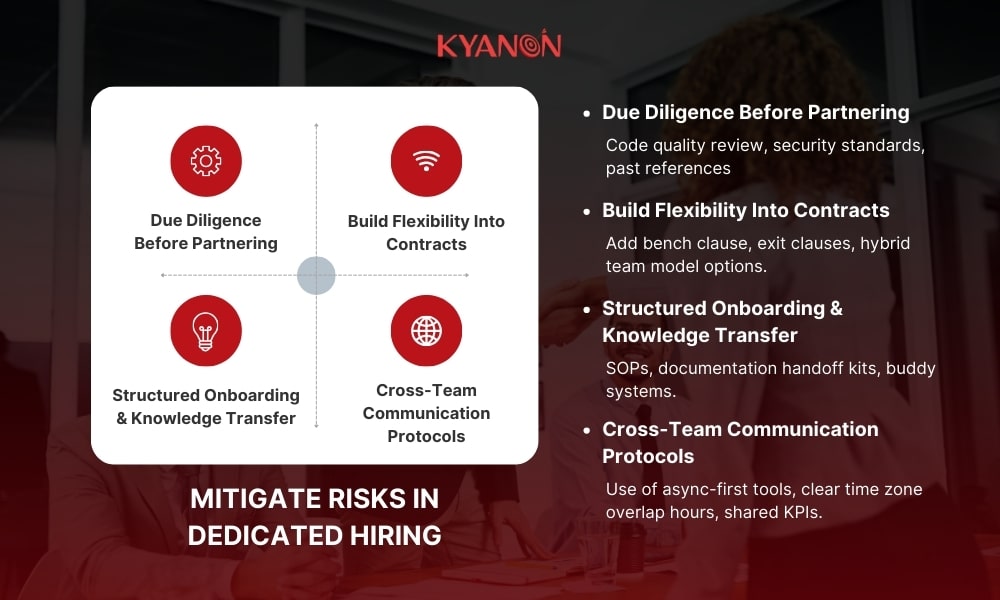
Structured onboarding & knowledge transfer
In the context of dedicated hiring, implementing a structured onboarding process is crucial for seamless integration. Utilizing Standard Operating Procedures (SOPs) ensures consistency and clarity, enabling new team members to understand workflows and expectations effectively. Comprehensive documentation handoff kits further facilitate knowledge transfer, reducing the learning curve and enhancing productivity.
To mitigate dedicated team hiring risks, incorporating a buddy system can be highly beneficial. Pairing new hires with experienced team members fosters a supportive environment, accelerates learning, and promotes cultural assimilation. This approach not only enhances the onboarding experience but also contributes to long-term team cohesion and retention.
Cross-team communication protocols
Effective cross-team communication is vital in dedicated hiring to ensure seamless collaboration across diverse time zones. Implementing asynchronous-first communication strategies – such as utilizing tools like Notion for documentation and Loom for video updates – allows team members to contribute without the constraints of overlapping schedules. Establishing clear protocols, including tiered urgency systems and designated response windows, fosters a predictable communication rhythm, enhancing productivity and reducing misunderstandings.
To mitigate dedicated team hiring risks, it’s essential to define core overlapping hours where real-time interactions can occur, facilitating prompt decision-making and alignment. Additionally, setting shared Key Performance Indicators (KPIs) ensures all teams are aligned towards common goals, promoting accountability and cohesion. By adopting these practices, organizations can navigate the complexities of global collaboration, maintaining efficiency and team synergy.
Red flags to watch for when hiring dedicated team
When navigating the complexities of dedicated hiring, it’s critical to look beyond surface-level promises and identify early warning signs that can derail your project. While dedicated hires offer access to specialized talent and flexibility, overlooking key red flags can lead to serious setbacks — from scope creep to delivery delays and compromised quality.
|
Red flags |
Consequences |
| Vague requirements | Scope creep, missed deadlines |
| Cost over quality | Subpar code, increased long-term costs |
| Inadequate skill assessment | Poor team integration, project failure |
| Ignoring time zones | Communication breakdowns, delays |
| Lack of screening | Underqualified hires, poor code quality |
| Unrealistic timelines | Burnout, compromised quality |
Red flags to avoid when hiring a dedicated team
The hidden costs of hiring a dedicated team often stem from vague requirements, unrealistic expectations, or insufficient vetting processes. Without a solid framework for assessing skill alignment, managing time zone overlap, and enforcing quality benchmarks, organizations risk burning time, budget, and internal trust. Vigilance during the vetting and onboarding phases can significantly reduce dedicated team hiring risks and ensure long-term value.
Checklist for a successful dedicated hiring strategy
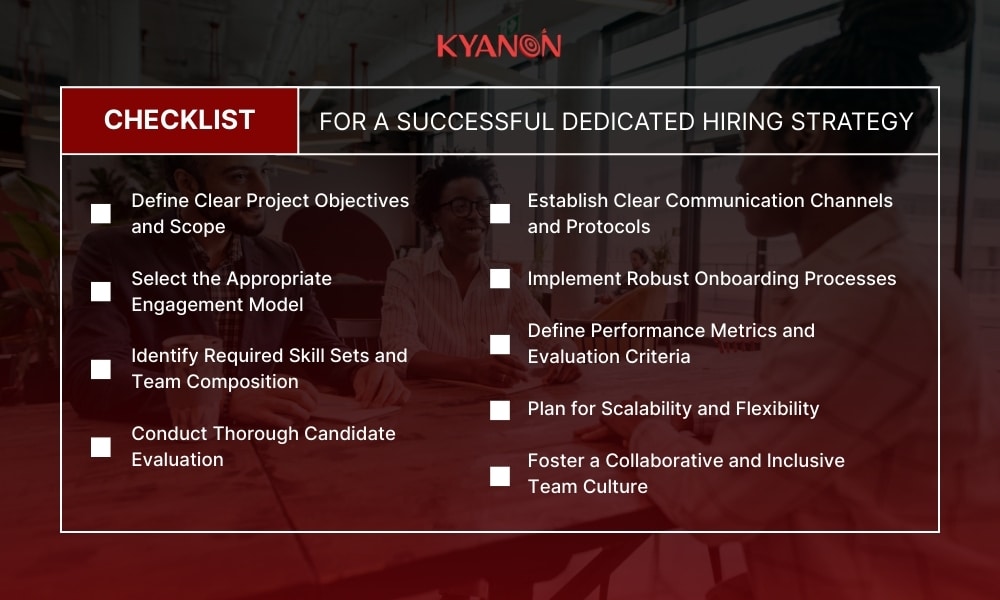
-
Define clear project objectives and scope
Establishing precise project goals and deliverables is fundamental, a well-defined scope mitigates misunderstandings and aligns the dedicated team’s efforts with organizational expectations. Clarity in objectives prevents scope creep, a common pitfall in dedicated team hiring risks.
-
Select the appropriate engagement model
Choosing the right engagement model – be it time and materials, fixed price, or dedicated team – is crucial. Each model carries its own set of advantages and potential hidden costs of hiring a dedicated team. A thorough analysis ensures alignment with project requirements and budget constraints.
-
Identify required skill sets and team composition
Determining the necessary technical skills and optimal team structure is essential for project success. A balanced mix of senior and junior developers can enhance productivity and knowledge transfer. Neglecting this balance may lead to inefficiencies, impacting the overall effectiveness of dedicated hires.
-
Conduct thorough candidate evaluation
Implementing a rigorous evaluation process, including technical assessments and cultural fit interviews, ensures that candidates meet the project’s demands. This diligence reduces the risk of underperformance and contributes to a more accurate dedicated hiring solutions cost analysis.
-
Establish clear communication channels and protocols
Defining communication tools and protocols fosters transparency and collaboration between in-house and dedicated teams. Regular updates and feedback loops are vital to prevent misalignments, a common issue in dedicated team hiring risks.
-
Implement robust onboarding processes
A structured onboarding process, complete with documentation and mentorship, accelerates integration and productivity. Effective onboarding minimizes the hidden costs of hiring a dedicated team by reducing ramp-up time and enhancing team cohesion.
-
Define performance metrics and evaluation criteria
Setting clear KPIs and evaluation standards allows for objective performance tracking. Regular assessments ensure that the dedicated team meets quality and timeline expectations, facilitating a more accurate dedicated hiring solutions cost analysis.
-
Plan for scalability and flexibility
Anticipating future project needs and potential scaling requirements ensures that the team can adapt to changing demands. Flexibility in team size and roles helps mitigate dedicated team hiring risks associated with project evolution.
-
Foster a collaborative and inclusive team culture
Promoting an inclusive environment encourages collaboration and innovation. Integrating dedicated hires into the company culture enhances engagement and reduces turnover, addressing some hidden costs of hiring a dedicated team.
Real-world success: Applying the dedicated team checklist at Kyanon Digital
At Kyanon Digital, our Dedicated Team service is built to eliminate the typical risks in outsourced development – such as unclear roles, inefficient onboarding, and hidden operational costs – through a structured, transparent, and scalable delivery model.
A standout example of this success is our collaboration with Temasek Life Sciences Laboratory (TLL). TLL approached Kyanon Digital with the goal of overhauling its outdated intranet system to better support research collaboration and internal communication. By leveraging a flexible dedicated software engineering team, we assembled a cross-functional unit comprising UI/UX designers, backend developers, QA engineers, and a project manager who worked in close alignment with TLL’s internal stakeholders.
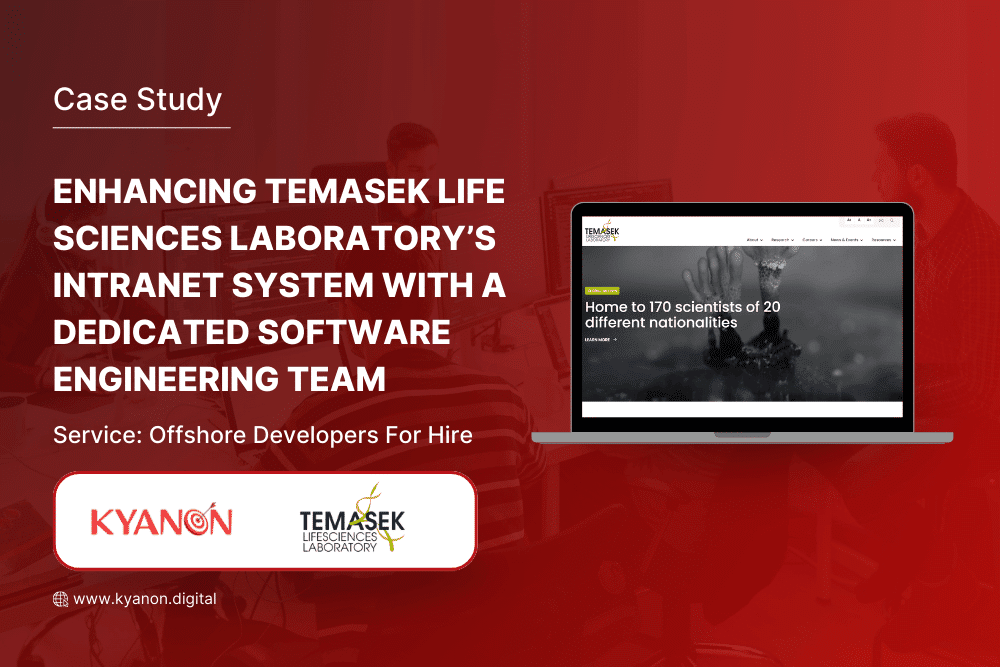
Throughout the project, our team applied agile best practices, including sprint planning, continuous delivery, and frequent retrospectives. We rebuilt the system’s architecture for better scalability, modernized the interface for enhanced usability, and integrated modules tailored to TLL’s scientific workflows. The clear division of roles, well-documented processes, and proactive communication ensured seamless integration with TLL’s internal operations.
As a result, TLL not only launched a robust and user-friendly intranet platform, but also experienced a marked improvement in internal engagement and operational efficiency.
This outcome directly reflected the benefits of following a dedicated hiring checklist – ensuring technical alignment, onboarding speed, and long-term value.
See how our dedicated team enabled real transformation here.
Eliminate all the risks of dedicated team hiring with Kyanon Digital

We’re a Tech Partner, Not a Recruiter
We build your team strategically, aligning talents with your software vision and roadmap, not just job requirements. With ongoing upskilling and expert support from our Center of Excellence, your talent stays ahead of challenges and delivers results.
Comprehensive Talent Ecosystem
Kyanon Digital talent ecosystem encompasses over 50,000 technology professionals
- Internal Talent Core: 300+ professionals
- K-Fresh Program: Nurturing Future Digital Leaders from 18 Universities in Vietnam
- External Talent Network: 15,000+ premium candidates
- Partner Network: 1,000+ trusted partners
Your One-Stop Talents Impact Solution
We manage from talent acquisition to HR management for your tech workforce, freeing your team to focus on core business and innovation.
Conclusion
Navigating the dedicated hiring landscape requires more than just selecting the right vendor – it demands a strategic approach that accounts for both visible expenses and the often-overlooked risks. From onboarding delays and infrastructure gaps to cultural mismatches and scope creep, the hidden costs of hiring a dedicated team can significantly impact your ROI if not proactively managed. By understanding these dedicated team hiring risks and conducting a thorough dedicated hiring solutions cost analysis, tech leaders can make informed decisions that drive sustainable success.
Contact Kyanon Digital today to hire a dedicated development team, eliminating all the risks while accelerating your product delivery!
Key takeaways:
- Thorough planning reduces scope creep: Misaligned expectations and vague project scopes are leading causes of scope creep in dedicated hiring. Clear documentation and well-defined KPIs are essential to prevent budget and timeline overruns.
- Onboarding time is a hidden cost: Dedicated hires typically require 2–4 weeks to reach full productivity, during which project velocity may dip. Structured onboarding and knowledge transfer protocols are critical to minimize delays.
- Infrastructure and time-zone challenges add operational friction: Unexpected tooling and environment setup costs, along with time-zone mismatches, can hinder collaboration and inflate total project expenditure. Early planning and asynchronous-first communication strategies help mitigate these issues.
- Cultural and role misalignment undermine team efficiency: A lack of technical and cultural fit, unclear roles, and overreliance on senior developers lead to inefficiencies and team friction. Balanced teams and clear role definitions improve cohesion and long-term performance.
- Risk mitigation requires flexible contracts and due diligence: Building adaptability into contracts and conducting deep technical and compliance assessments are vital to avoid pitfalls. A robust dedicated hiring solutions cost analysis ensures ROI and alignment with business goals.
References:
- IT services outsourcing market size, share, and trends 2024 to 2034, Precedence Research
- Avoiding the most common mistakes when hiring a dedicated software development team, Planeks
- 8 mistakes to avoid when hiring a dedicated development team: A guide, iBrandStudio
- Avoiding the pitfalls: How to choose the right dedicated team for your project, Weboconnect
- Are there any risks associated with hiring dedicated mobile developers?, Moldstud
- How to hire a dedicated development team, Debut Infotech
- In-house vs. dedicated team: Which is the right choice for your business?, Cosmic Development
- Outsourcing vs in-house development: Which is more cost-effective?, Moldstud
- In-house development vs outsourcing, Brainhub
- Comparing outsource software development vs in-house development: a cost analysis approach, GT Procurement
- Hidden costs of remote development, Full Scale
- How much does it cost to hire a development team?, Debut Infotech
- Cost-effective outsourcing vs. in-house development, Moldstud
- Remote engineering onboarding checklist, Full Scale
- How to improve onboarding and decrease your software engineer ramp time, Pluralsight Flow Academy
- Reducing ramp-up time, Enboarder
- The hidden cost of poor documentation in software development, Evizi
- Why bad workflows are silently killing your velocity (and how to fix it), GitKraken
- Onboarding best practices, Forbes Advisor
- Onboarding SOPs, Scribe
- Key security and compliance practices when hiring an offshore dedicated development team, Recruit Ninjas
- Technical due diligence, ElifTech
- Flexibility clauses in contracts, Witan Solicitors
- The hidden price of poor offboarding, Career365
- How to mix junior and senior engineers in a team, LeadDev
- Role clarity and psychosocial hazards, Comcare
- Hiring pitfalls for managers to avoid – and what to do instead, Forbes Human Resources Council
- Best practices for managing remote teams across time zones, Talenteum
- Hiring process checklist: Step-by-step guide, Hire Success


